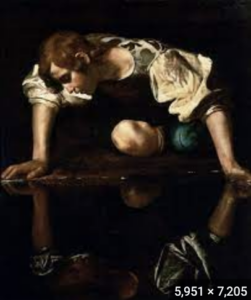Sir Frank Dicksee subtly captures Keates entire poem in one scene that emphasizes the troubling gender reversal that bothers the knight immensely. When the knight begins to recount is day with the lady, the meter breaks: “I met a lady in the meads / Full beautiful, a fairy’s child; / Her hair was long, her foot was light, / And her eyes were wild” (l. 13-16). There are two traditional impulses at work in these lines. The first is how the speaker wants to catalogue the lady’s graces, a hallmark of the Petrarchan sonnet tradition extended out of its original form. The second is the rhyme scheme, abcb, which is a ballad rhyme typically used for joyful or love poems. However, the meter is broken at the fourth line of each stanza from melodic quatrameter to jarring dimeter. In these stanzas there is a clear tension for the speaker between being bewitched by the lovely lady and trying to wake himself up from her spell. In the portrait as well, the movement is driven and controlled by La Belle Dame: the horse she rides is plausibly poised to move forward, and her hands on the bridle and saddle follow that line which wants to move away from the knight. The knight’s knees are bent as if he is losing his drive to follow her, and he is losing his grip on the horse. It is as if the painter has captured the moment of realization between the third and fourth lines where he tries to shake himself from her spell, losing his balance in the process and extending his arms. He is not in control of the momentum of the painting or the poem, and this is unsettling to him as the noble man who typically has control.
The knight is enthralled by La Belle Dame’s gaze, and getting closer to the lover’s eyes is important. But first we must reexamine the poem when the knight has a sublime vision of his ruin: “I saw pale kings, and princes too, / Pale warriors – death-pale they all – / Who cried: ‘La belle dame sans merci / Hath thee in thrall!” (l. 37-40). The meter break keeps with the established pattern, setting up a community of men urging him to wake up so he won’t be another victim of this woman’s seductions. In the painting, the knight doesn’t quite meet her eyes, instead gazing at the flower crown which has three small flowers drifting down toward him. The knight mentions that he sees three pale men who urge him to wake up, and his eyeline toward these blossoms could be the artist gesturing toward this sublime awakening. Moreover, either he has extended his hand toward another grove of flowers, or they grow toward him. In either viewing, these flowers could be the other male victims who foreshadow his fate if he remains entranced.
This poem is concerned with the gendered role of the casual initiation of sex as valorized for men and demonized for women. Considering that the Pre-Raphaelites were deeply interested in returning to the Renaissance paradigm of art, it would be interesting to consider this painting alongside Caravaggio’s “Narcissus.” La Belle Dame in Dicksee’s painting and Caravaggio’s Narcissus have similar posture, leaning over the object of their desire, though La Belle Dame is in the dominant position. This is likely the place the knight hoped to put himself in, and is embarrassed by the reversal which literally puts him face to face with his own hypocrisy and vanity – ultimately the cause of ruin for both men.


Left: “Narcissus” by Caravaggio
Right: “La Belle Dame Sans Merci” by Sir Frank Dicksee
